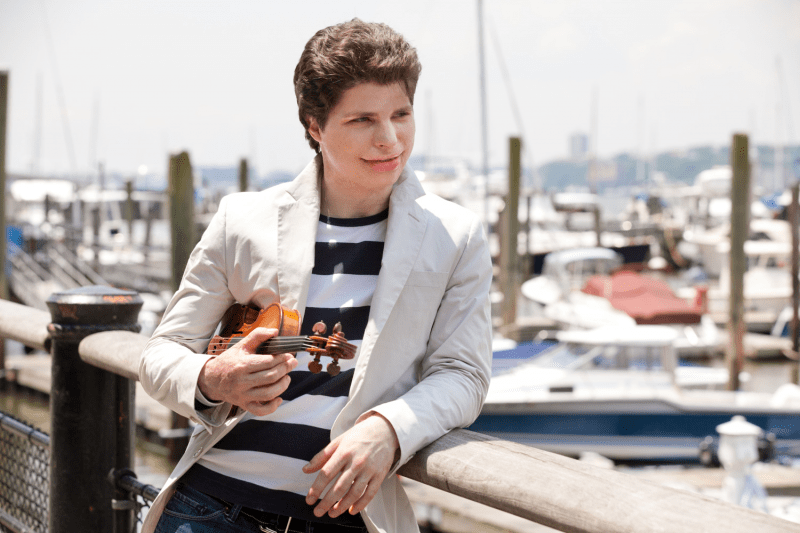At the Schermerhon
The Nashville Symphony Enters Orbit!
The Nashville Symphony audience has finally broken the stigma about only clapping in the “appropriate” spots during a concert. And Thursday night gave the audience plenty of reasons to clap. This weekend the Nashville Symphony presents a solid program of favorites: Kaija Saariaho’s Asteroid 4179: Toutatis, Tchaikovsky’s Violin Concerto, and Gustav Holst’s The Planets. The evening began with Maestro Guerrero mounting the podium and introducing the newest members of the orchestra. I could only really hear the first names as the audience’s eagerness to welcome the newest members drowned out the rest. This enthusiasm never let up throughout the night.

The opening piece was Asteroid 4179: Toutatis by Finnish composer Kaija Saariaho. It is a four-minute orchestral depiction of the asteroid whose orbit comes the closest to earth. But no need to worry, at its closest point it is still over 4.5 million miles away. Saariaho was originally asked to write this piece by Simon Rattle and the Berlin Philharmonic for their 2006 “Ad Astra” project. This project, which culminated in a CD, commissioned contemporary composers to add several space themed pieces to accompany Gustav Holsts’ The Planets. On Thursday night the Nashville Symphony played the Toutatis perfectly well, . The piece is slow, eerie, and ethereal with polyrhythms and fragments of disjointed lines throughout. For those curious the full score to the piece can be viewed on Saariaho’s website. (https://saariaho.org/works/asteroid-4179-toutatis/) Loud applause filled the hall at the piece’s quiet end, though it was nothing compared to the applause yet to come.
The chief success of the night was Augustin Hadelich in Tchaikovsky’s Violin Concerto. The price of admission is worth it just for this piece alone. Hadelich is a true superstar. Nashville always treats its audience with great soloists, but Hadelich stands a cut above the rest. The concerto, written in 1878, was Tchaikovsky’s only violin concerto and is a perennial favorite for good reason. It is a perfect showcase piece for a talented violinist that runs the gamut from raw firework technicality to lyrical musical bliss. The opening movement is notoriously virtuosic, but in Hadelich’s hands there was never any doubt about the musical result. It was perfection throughout. At the end of the movement the audience gave a hearty standing ovation.

The second and third movements (played attaca, much to the chagrin of the waiting-to-clap audience) are where the whole ensemble shined. The Nashville string section was incredibly rich throughout the Canzonetta. When the transition was made to the Finale, Hadelich took an incredibly brisk pace, but the ensemble was up to the task. Bravo to Giancarlo and the symphony for the fantastic performance and my personal highlight of the concert. After a long-standing ovation and several curtain calls, Hadelich played an encore that brought the audience’s excitement to even greater heights.
The second half of the concert consisted of Gustav Holsts’ most popular work: The Planets. This piece is one of the rare examples of “classical music” breaking out into the larger public conscious. Everyone has heard the playfulness of “Mercury,” the noble hymn theme in “Jupiter,” and the fearful might of “Mars” (or at least Hollywood imitations of it). The orchestra’s performance of the piece was comfortable. No great liberties were taken with interpretation, but by no means does that mean the performance was lackluster. The brass section dominated the ending of “Mars” in the loudest moment of the evening. “Venus,” the perfect counterpart to “Mars,” was led by fantastic playing by the celeste and dual harpists. The ensemble brought out the great bitonality of the tricky “Mercury.” The movement “Jupiter” is such a successful piece of music on its own, that its middle section has been turned into a popular British hymn “I Vow to Thee, My Country.” It was a real pleasure to see and hear the whole ensemble enjoying themselves in that movement. The fifth movement, “Saturn, the Bringer of Old Age” is my personal favorite. Holst does a masterful job of depicting a ticking clock and an elderly person struggling under the weight of old age. My only complaint with this performance was the use of tubular bells at the climax of the movement. They overly dominated the sound texture so greatly that people were turning their heads to see where the sound was coming from.
“Uranus, the Magician” playfully depicts the trickster mage. Towards the end of the movement the organ plays a massive glissando before disappearing in an instant to leave behind delicate strings holding a chord. It is a great musical moment. Guerrero left his hands up at the end of the movement to facilitate a smooth transition to the quiet beginning of the last movement, “Neptune.” But the audience’s clapping won out again. Orchestra members smiled as the applause slowly gained steam, but the movement was resumed quickly enough. The final movement ends quietly but with the greatest effect. There is an offstage woman’s chorus that sings a simple wordless melody that twists and turns the ear as their song slips into different key areas. Holst has them singing for a few minutes until they recede off into the distance getting quieter and quieter. At the Schermerhorn this was managed by slowly closing the stage doors to dampen the sound. Besides a few door creaks at the beginning of the close, the motion was done with great effect. It really escapes description but suffice it to say that it was one of the best performances that I have heard live.
If you have the chance to hear the symphony in their remaining two performances this weekend, I cannot recommend it highly enough. For more information about the remaining performances, click here (https://www.nashvillesymphony.org/tickets/concert/2022-2023-season/classical-2-holst-s-the-planets/)



